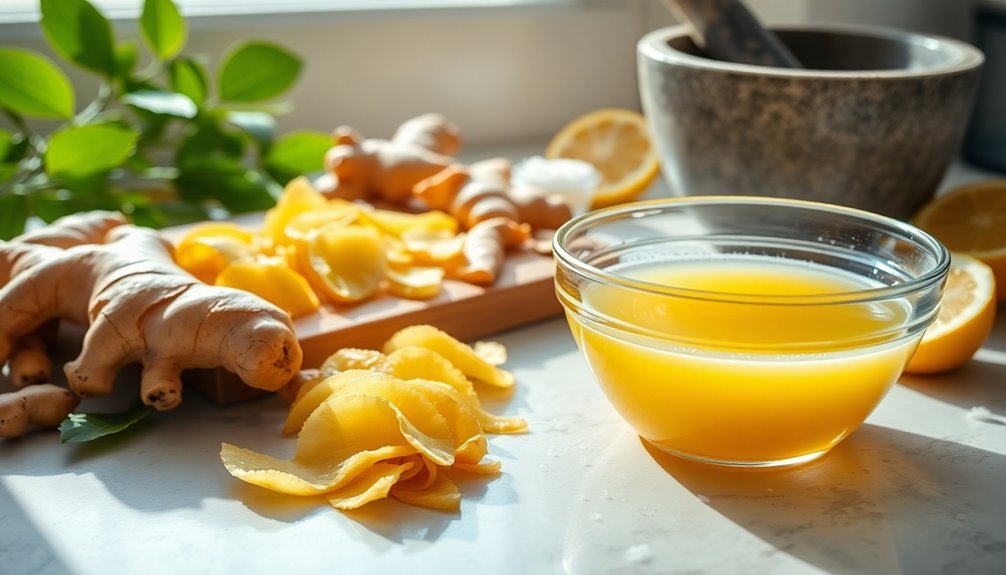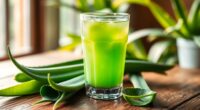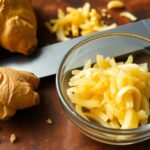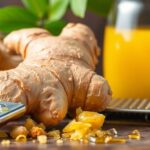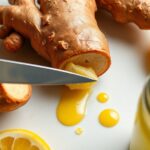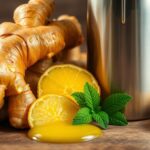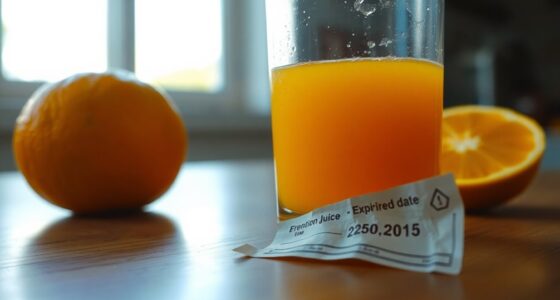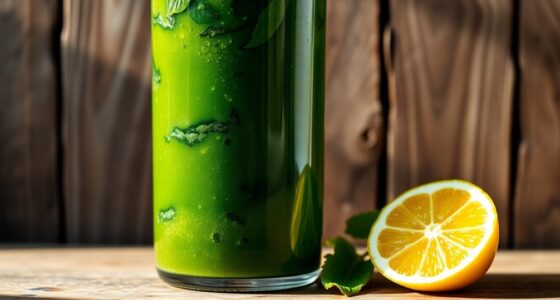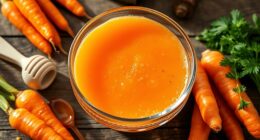To make ginger juice without a juicer, start by chopping fresh ginger into 1-inch pieces. Blend the ginger with filtered water until smooth. Strain the mixture using a fine mesh strainer or nut milk bag to extract the juice. Store it in an airtight container in the fridge for up to a week or freeze it in ice cube molds for longer use. Want to discover tips on enhancing flavor or other uses for leftover pulp?
Key Takeaways
- Chop fresh ginger root into uniform 1-inch pieces for even blending and juice extraction.
- Blend chopped ginger with 1 cup of filtered water until smooth for maximum juice yield.
- Strain the blended mixture using a fine mesh strainer or nut milk bag to extract the juice.
- Store the ginger juice in an airtight container in the refrigerator for up to one week.
- Freeze any leftover juice in ice cube molds for easy use in future recipes.
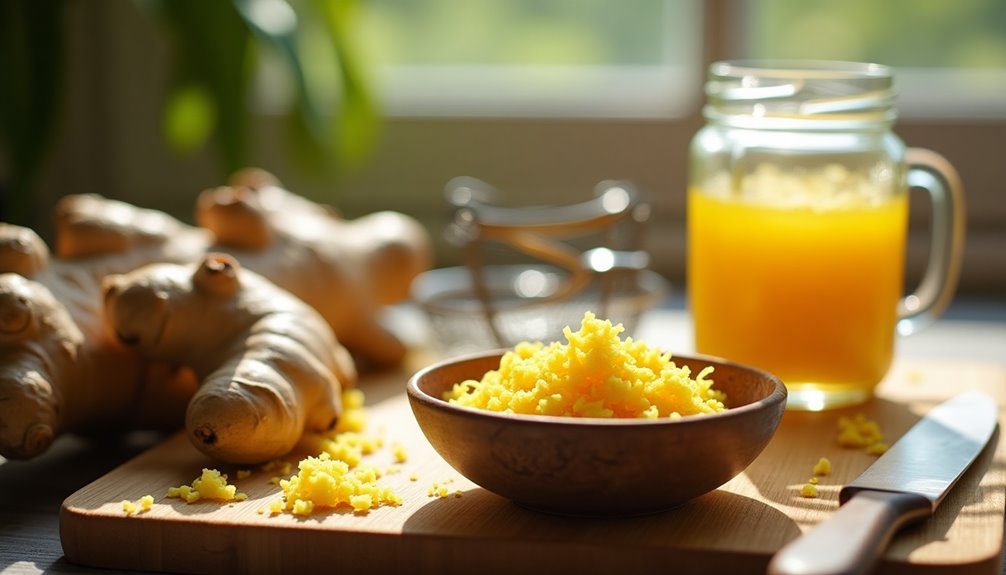
If you want a refreshing and zesty drink, making ginger juice at home is a simple and rewarding process. You don't need a juicer to create this invigorating beverage; all you need is fresh ginger and a few common ingredients. This juice recipe not only tantalizes your taste buds but also packs a punch of health benefits. Ginger is known for its anti-inflammatory properties and potential to aid digestion, making it a great addition to your diet.
To start, gather your fresh ginger root. Look for firm, plump pieces, as they'll yield the most juice. Once you've got your ginger, chop it into 1-inch pieces. This makes it easier to blend and ensures you extract maximum flavor.
Next, you'll need to combine the chopped ginger with filtered water. For a single serving, use about one cup of water. This fluid will help break down the ginger, making it easier to extract the juice.
Now, it's time to blend. Add the ginger and water to your blender and blend until the mixture is smooth. You want to ensure that the ginger is finely processed to release as much juice as possible. If you want to enhance the flavor and nutritional values of your ginger juice, consider adding coconut water or a splash of lemon juice at this stage. Coconut water not only provides additional hydration but also brings a subtle sweetness that balances the spiciness of the ginger.
Once you’ve blended the ginger and water, the next step is to strain the mixture. Using a fine mesh strainer or a nut milk bag, pour the blended mixture through and press down on the pulp to extract as much juice as possible. This step is crucial—don’t skip it! You’ll be left with a fragrant and refreshing ginger juice that you can enjoy immediately or store for later. Once you’ve strained the mixture, you may want to add a touch of sweetness by incorporating honey or maple syrup, depending on your preference. To elevate the flavor, consider mixing in a splash of lemon or lime juice for a zesty kick. Now that you know how to prepare ginger juice, you can experiment with different additions, such as turmeric or mint, to tailor it to your taste. Enjoy your homemade ginger juice as a refreshing drink or a health booster!
Speaking of storing, you can keep your fresh ginger juice in an airtight container in the refrigerator for up to one week. If you want to preserve it for longer, consider freezing the juice in ice cube molds. This way, you can easily pop out a cube whenever you want a quick ginger boost or to use in recipes, like ginger tea.
Don't forget about the leftover ginger pulp! Instead of tossing it away, save it for other recipes. You can use it to make ginger tea or even dry it out to create your own ginger powder. This not only minimizes waste but also allows you to enjoy the health benefits of ginger in various forms.
Frequently Asked Questions
How to Juice Ginger by Hand?
To juice ginger by hand, start by peeling the ginger root using a spoon or peeler to keep its nutrients intact.
Chop the peeled ginger into 1-inch pieces, then blend it with a cup of filtered water until smooth.
Strain the mixture through a fine mesh strainer or nut milk bag, pressing the pulp to extract all the juice.
You can store the ginger juice in an airtight container in the fridge or freeze it for later use.
Is It Better to Boil or Juice Ginger?
When deciding whether to boil or juice ginger, consider your goals.
Juicing retains more nutrients and active compounds, like gingerol, which are beneficial for health. If you boil ginger, you might enhance its flavor, but some antioxidant properties could diminish.
If you want a potent health boost, juicing's the way to go. However, if you're after a warm, flavorful infusion, boiling could be your choice.
It really depends on your preference and intended use!
Is It Safe to Drink Raw Ginger Juice?
Ginger's like a fiery friend; it brings warmth and health when welcomed in moderation.
Yes, it's generally safe to drink raw ginger juice, but keep it to about 30ml daily to sidestep issues like heartburn.
While gingerol offers fantastic health benefits, you might want to start slow to see how your body reacts.
If you're pregnant or on medication, especially blood thinners, you should consult your doctor before diving in.
Can You Blend Ginger Instead of Juicing?
Yes, you can blend ginger instead of juicing it!
Just chop the ginger into 1-inch pieces, then blend it with water. A good ratio is 5 ounces of ginger to 1 cup of water.
Once you've blended it to a smooth consistency, strain the mixture through a fine mesh strainer or nut milk bag to separate the juice from the pulp.
You can use the leftover pulp creatively in other recipes too!
Conclusion
Making ginger juice without a juicer is like crafting a flavorful potion in your kitchen. By grating, soaking, and straining, you can extract the zingy essence of ginger with just a few simple steps. This homemade juice not only adds a kick to your dishes but also offers numerous health benefits. So, embrace the adventure of DIY ginger juice, and let your creativity flow, transforming raw ingredients into a refreshing elixir that invigorates both body and spirit.
Cindy thoroughly researches juicing trends, techniques, and recipes to provide readers with practical advice and inspiration. Her writing style is accessible, engaging, and designed to make complex concepts easy to understand. Cindy’s dedication to promoting the advantages of juicing shines through her work, empowering readers to make positive changes in their lives through the simple act of juicing.

